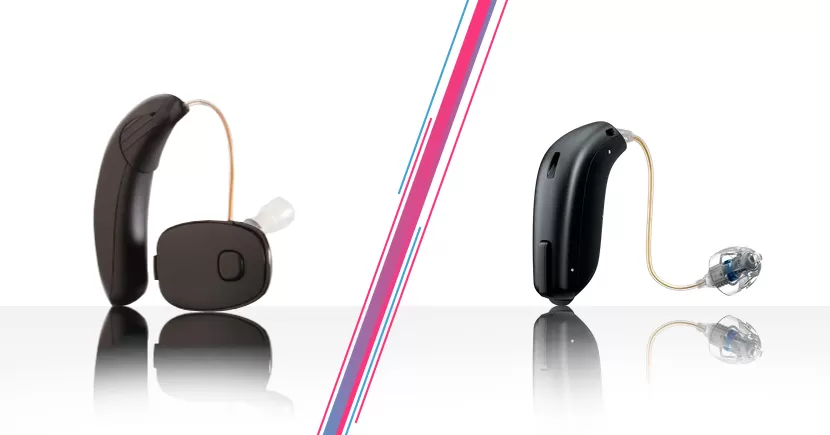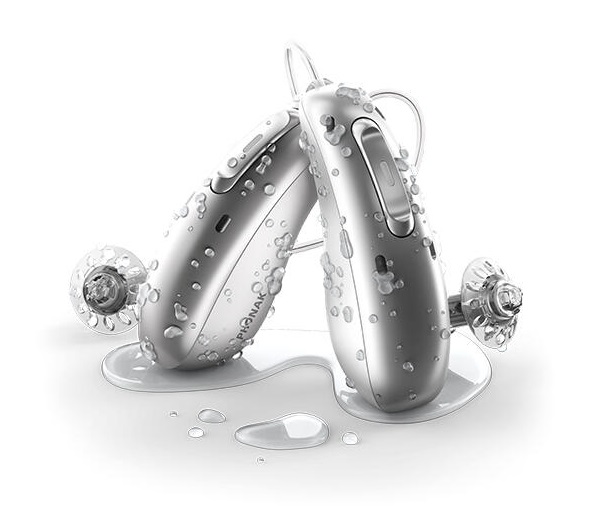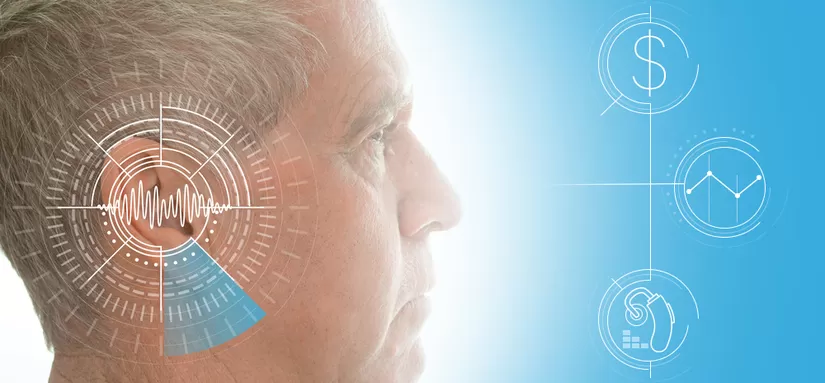1.
Microphone
The microphone picks up the sound from the environment and sends it into the hearing aid for processing. You’ll mostly want to leave the microphone alone, but periodically check it to ensure it’s not being plugged up by hair care products or oils.
2.
Receiver
The receiver AKA speaker delivers the sound into the ear. Depending on the severity of your hearing loss, your hearing care provider will instruct Signia to build your Insio Charge&Go hearing aids with one of three different receiver strengths: 50 dB, 55dB, or 65 dB.
3.
Rechargeable battery
Insio Charge&Go hearing aids are powered by a rechargeable lithium-ion battery, expected to last up to 20 hours/day. The battery takes about 3 hours to fully charge, and a 30 minute quick charge will get you about 6 hours of power. These batteries will last about 3 years, and the first battery replacement is covered under your 3 year hearing aid warranty.
4.
Push button
The push button can be programmed by your hearing provider to have different functions, depending on your needs. Some of these functions include volume and program control, on/off functionality, TV streaming (when used with a Streamline TV device), and with iPhone 11 or newer phone calls can be answered by using the push button. Some people use this button exclusively to control the hearing aids, and others use the app to control the hearing aids. Others (most people), use a combination of both the app and push button to make adjustments to their hearing aids. You likely won’t have to use this button often, but some people find it handy to make quick adjustments to their hearing aids when they change listening environments (ie, entering a noisy restaurant, or a quiet room). Your hearing provider will go over the options available and make sure your hearing aids are set up to your ideal preferences.
5.
Vent
The vent runs along the entire hearing aid, usually along the bottom portion, with an opening at the faceplate of the hearing aid (outside the ear), and an opening next to the receiver/speaker of the hearing aid (inside the ear). Vents serve multiple purposes, from aiding in ventilation, to controlling sound leakage and feedback reduction. Vents can affect acoustics and sound quality, so your hearing care provider and the manufacturer will take care to ensure your hearing aid is built with the correct vent size.
6.
Wax filter
When it comes to maintaining your hearing aids, this is where you’ll spend most of your time. The wax filter (mostly) prevents wax and oils from getting into the receiver/speaker. Your hearing provider may supply you with Signia’s Cerustop 3.0 wax filters enabling you to periodically change these on your own. Some people never have to change these wax filters, others have to change them weekly. Your purchase includes 1 pack of wax filters, and you can purchase additional wax filters directly from your ZipHearing provider, or through a number of sites online such as Amazon.
7.
Microphone
The microphone picks up the sound from the environment and sends it into the hearing aid for processing. You’ll mostly want to leave the microphone alone, but periodically check it to ensure it’s not being plugged up by hair care products or oils.
8.
Receiver
The receiver AKA speaker delivers the sound into the ear. Depending on the severity of your hearing loss, your hearing care provider will instruct Signia to build your Insio Charge&Go hearing aids with one of three different receiver strengths: 50 dB, 55dB, or 65 dB.
9.
Rechargeable battery
Insio Charge&Go hearing aids are powered by a rechargeable lithium-ion battery, expected to last up to 20 hours/day. The battery takes about 3 hours to fully charge, and a 30 minute quick charge will get you about 6 hours of power. These batteries will last about 3 years, and the first battery replacement is covered under your 3 year hearing aid warranty.
10.
Push button
The push button can be programmed by your hearing provider to have different functions, depending on your needs. Some of these functions include volume and program control, on/off functionality, TV streaming (when used with a Streamline TV device), and with iPhone 11 or newer phone calls can be answered by using the push button. Some people use this button exclusively to control the hearing aids, and others use the app to control the hearing aids. Others (most people), use a combination of both the app and push button to make adjustments to their hearing aids. You likely won’t have to use this button often, but some people find it handy to make quick adjustments to their hearing aids when they change listening environments (ie, entering a noisy restaurant, or a quiet room). Your hearing provider will go over the options available and make sure your hearing aids are set up to your ideal preferences.
11.
Vent
The vent runs along the entire hearing aid, usually along the bottom portion, with an opening at the faceplate of the hearing aid (outside the ear), and an opening next to the receiver/speaker of the hearing aid (inside the ear). Vents serve multiple purposes, from aiding in ventilation, to controlling sound leakage and feedback reduction. Vents can affect acoustics and sound quality, so your hearing care provider and the manufacturer will take care to ensure your hearing aid is built with the correct vent size.
12.
Wax filter
When it comes to maintaining your hearing aids, this is where you’ll spend most of your time. The wax filter (mostly) prevents wax and oils from getting into the receiver/speaker. Your hearing provider may supply you with Signia’s Cerustop 3.0 wax filters enabling you to periodically change these on your own. Some people never have to change these wax filters, others have to change them weekly. Your purchase includes 1 pack of wax filters, and you can purchase additional wax filters directly from your ZipHearing provider, or through a number of sites online such as Amazon.




















->getDescriptorURL()?>)















![Buying Hearing Aids Online [Pros & Cons, Tips] Preview for the "Buying Hearing Aids Online [Pros & Cons, Tips]" video](https://cdn.ziphearing.com/dist/dynamic/files/videos/8/thumbnail/version/1/80/thumbnail.jpg)

![Rechargeable Hearing Aids [Pros & Cons] Preview for the "Rechargeable Hearing Aids [Pros & Cons] " video](https://cdn.ziphearing.com/dist/dynamic/files/videos/20/thumbnail/version/1/80/thumbnail.jpg)




















